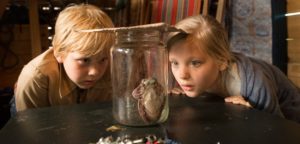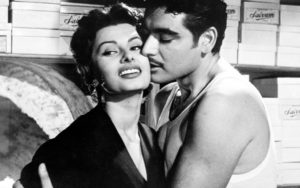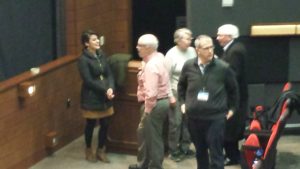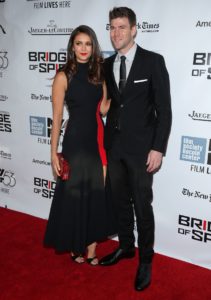 Discuss: Wisconsin Film Festival
Discuss: Wisconsin Film Festival
Jimbo’s Halftime Report
Wisconsin Film Festival continues at Union South Marquee (Nick Offerman Day) and Sundance Cinemas»
James Kreul shares some preliminary thoughts on the first half of the 2017 Wisconsin Film Festival. Topics include admitting what he missed in his previews; applauding students for affirming their own brand; and spinning a “tale of two festivals.”
Last year, my Festival burnout was so thorough that I never followed up on many things I usually do, like a ranked list of films seen and a wrap up beyond the first weekend. This year we’re doing things at a deliberately slower pace, so while we won’t match the output of our 10-day preview, we should have some good stuff this week without running ourselves into the ground. Edwanike Harbour will share at least one more review, and Jason Furhman will share his viewing notes in the coming days.
Don’t forget that today is Nick Offerman day at the Union South Marquee Theater. Titles include Look & See: A Portrait of Wendell Berry, My Life as a Zucchini, The Hero, and Infinity Baby.
 What I Overlooked Last Week
What I Overlooked Last Week
My short take: Programming has been strong again this year. In a sense, that’s all that matters.
As of last week, we had devoted 13,000 words to the Festival, and that was not enough. Many films that deserve attention fell through the cracks. There’s no real solution to this, of course, but it’s worth mentioning a few titles that seem to have significantly shaped the Festival experience for several people, based on ticket line conversations.
The Gold of Naples: While I mentioned this in passing in my Isthmus coverage of restorations, I still haven’t caught up with it (and won’t until after the Festival). In that article I did suggest that the thrill of the hunt with the restorations can lead to as many thrilling discoveries as the premieres. It’s that sense of eye-opening surprise that seems to be the takeaway for many people I’ve talked to about the Gold of Naples screenings. Update 4/4: Even David Bordwell calls The Gold of Naples “the nicest surprise” of his retrospective viewing.
Wet Woman in the Wind: The descriptions I had read made this one dicey to address without having seen it. Part of me wanted it to be like Shu Lea Cheang’s I.K.U., which I had hoped to bring as the first digitally projected feature at the Wisconsin Film Festival after I saw it at Sundance in 2000. (There was no way that was going to happen.) But the other part of me worried that it would be like the one pink film I’ve seen, Hosoyama Tomoaki’s A Weather Woman, which was pretty tedious despite having a reputation for humor within the genre. I watched that with a major film scholar; I don’t recall either of us laughing. Wet Woman in the Wind ended up somewhere in between those two films: the crazy and ambitious staging of the former and the humor of the later (successful, this time). I wish I had pointed it out to more people before the screenings.
Mr. Frog: I openly admit we don’t cover some films in the Madison Film Forum. We tend not to cover the Wisconsin’s Own films, for example, in part due to the fine coverage of those films at LakeFrontRow, which we link to whenever possible. The other obvious blind spot, however, has been the Big Screens, Little Folks programming strand, a blind spot we may have to address in future years.
I’ll also admit that when Edwanike Harbour and bounced ideas around for her next review based on what she saw over the weekend, when she listed Mr. Frog, I quickly moved on to the other films on her list. After hearing Mr. Frog come up during conversational requests for bests and worsts while waiting for films, I need to question my own hesitance on several grounds.
First, if we repeatedly address the aging of the Wisconsin Film Festival audience (which we will do again below), we should balance that with some discussion of the educational initiatives the Festival has taken (in addition to the Madison Public Library Sneak Peeks). Second, even more so than international art cinema, international children’s cinema receives scant critical attention in the American popular press. While I keep lamenting the fact that Palm d’Or winners no longer receive theatrical engagements in Madison, the Big Screens, Little Folks films have absolutely no chance of returning to the big screens in Madison. And finally, these films present an opportunity for a very different filmgoing experience, as suggested by a video the Festival posted on Facebook this morning.
WUD Film Distinguishes Its Brand
In the intro to my Big Auteurs preview I suggested, without much evidence, that perhaps the WUD Film Committee was more interested in doing their own thing than getting ramped up for the Wisconsin Film Festival these days. My circumstantial evidence included the decision to schedule the Directress Film Festival on the weekend when most press attention traditionally focuses on the release of the Wisconsin Film Festival Film Guide. WUD Film remains a partner in the Wisconsin Film Festival, but their “This Week in WUD Film” Facebook posts have prompted me to further question health of the relationship.
This issue here is not that WUD promotes their programs this week that conflict with the remaining Wisconsin Film Festival programs at Sundance. No one would expect WUD to take the week off. They should get right back to what they do best.
What I find curious is that the ‘Nick Offerman Day” programs at the Union South Marquee Theater today are not included in the post, despite WUD Film being a Festival partner.
One would think that WUD Film would be interested in foregrounding their partnership in this event that has generated interest beyond traditional Festival audiences (translation: the kids today like Nick Offerman, what gives?).
WUD Film did not exactly go out of their way to identify themselves as a Festival partner on social media, especially on Facebook. Since March 27, WUD Film posted eight times on Facebook, and only 1.5 of those posts (here and here) promoted the Wisconsin Film Festival. In both cases the same curious language was used: the Wisconsin Film Festival “takes over” the Marquee Theater this week. That’s very different from “we’re partnering with the Wisconsin Film Festival to present…”
If I were a responsible journalist or something, I would ask for comment. But I’m not sure if I want to put a student on the spot to explain what seems to be pretty obvious. WUD Film distinguishes its own programming from Wisconsin Film Festival programming despite being a partner. That’s a pretty dramatic change from the first years of the Festival, now approaching 20 years ago. The change has been so slow and gradual from year to year that it hasn’t been discussed widely.
I admire current WUD Film students for working very hard to distinguish its own programming and, in a sense, disregarding the shadow of Wisconsin Film Festival as WUD does what it wants to do in March and April. In the long term, a stronger and more ambitious WUD Film is good for Madison film culture as a whole, especially as the Marquee remains the only venue capable of multiple-day engagements in the downtown area.
The growing gap between the Wisconsin Film Festival and bottom-up campus film culture (you know, student film culture) signals a potential problem for the long term health of the Festival. While several students, and several individual WUD Film members. have committed themselves to the success of the Wisconsin Film Festival (especially as volunteers at the Marquee over the weekend), in general students are not buying in. If you don’t believe me, just look at the aging crowd in the lines and in the seats—especially at the campus venues.
Imagine another scenario, however. What if there were a way to integrate the energy and intellectual curiosity behind the Directress Film Festival into the Wisconsin Film Festival? What if students discussed the Wisconsin Film Festival as something that they had a personal investment in, instead of something that has “taken over” their space for a few days? That wouldn’t be that hard to achieve. In fact, that was the starting point in 1999, when students selected the first film of the inaugural Festival, Man of the Century.

A Tale of Two Festivals
In the early days of the Wisconsin Film Festival, I took pride in having a very different Festival experience than most people. I never saw Debra Winger. I saw but never met Roger Ebert (even though his introduction to A Hard Day’s Night was the first time my mother asked me to get tickets a Festival event). Much of what I saw had very little local coverage.
This continues to be a strength of the Festival, and most good festivals. At any given time people can have wildly different experiences and still say they enjoyed the same event. The most radical juxtaposition this weekend was Sunday’s world premiere of The 60 Yard Line at the Barrymore scheduled opposite the visit from Terence Davies with his latest feature A Quiet Passion at the Marquee.
Last week I was critical of the fact that the Davies visit seemed buried in the Festival coverage, and that ticket sales seemed to be slow compared to the quick-selling 60 Yard Line. My concern was unfounded, at least in terms of the final turnout for Davies. His visit still flew under the radar in the local media, but the Marquee was packed and the audience responded very enthusiastically, not only to the film but to Davies himself during the intro and Q & A session.
[My quick take on A Quiet Passion: You know going in which Emily Dickinson poem has to be used at the end. But somehow the end still surprised me, or perhaps I should say my emotional response to it surprised me quite a bit. It wasn’t until those ending images and words that I realized how the film had been working on me and my emotions all along. It’s a beautiful film, and a cathartic experience watching it, if you allow yourself to be open to that experience.]
Meanwhile, something very different was going on at the Barrymore. That doesn’t mean I disapprove, I just mean very different. By all accounts, a good time was had by all at the premiere of The 60 Yard Line. On Facebook, my colleague Edwanike Harbour has described seeing the film along with Ahman Green, Mark Tauscher, and the cast and crew as the highlight of her Festival.

But the nature of the event was different. There was an attempt to imitate a red carpet opening. At first I thought the programmers made a mistake scheduling A Quiet Passion against The 60 Yard Line. I now believe that doing so gave them an out. They got to hang out with Terence Davies. They didn’t have to deal with playing make believe, imitating what we see on Entertainment Tonight, Extra, and TMZ.
Maybe the wider attention to The 60 Yard Line, and the relative quiet over Davies, was worth it. Coverage of the premiere reached all the way to the Green Bay Press-Gazzette; a quick glance at the Festival press coverage this year suggests that this was the only Festival coverage in the Press-Gazzette. But that very attention might come back to haunt the Festival.
In terms of optics, it seems like control of the event was handed over to the filmmakers. Those optics, on display in the wide coverage, could establish new expectations for what Wisconsin filmmakers can expect the Festival to do at the premieres. I’m not sure if it was in the interest of the Festival to relinquish control of those optics, or the brand of the Wisconsin Film Festival itself.
 Just as WUD Film has now asserted its brand, the Festival has to make sure it retains control of its brand that it has built over the past 19 editions. The 60 Yard Line filmmakers could have had a red carpet premiere at any time and any place, but they utilized the Wisconsin Film Festival brand to generate interest in their premiere.
Just as WUD Film has now asserted its brand, the Festival has to make sure it retains control of its brand that it has built over the past 19 editions. The 60 Yard Line filmmakers could have had a red carpet premiere at any time and any place, but they utilized the Wisconsin Film Festival brand to generate interest in their premiere.
Somehow, that favor was not returned in the red carpet optics. The step and repeat red carpet wall only featured the logo for The 60 Yard Line. The photo on the left (from the New York Film Festival) suggests how festivals usually address this, never relinquishing control of the event or the brand. Despite the resources the Wisconsin Film Festival allocated to making the premiere happen, there was little return on that investment in terms of optics—not one of the Press-Gazzette photos features a Wisconsin Film Festival logo. I’m not particularly interested in how this happened, and I don’t blame the filmmakers because it is not their responsibility to retain control of the Wisconsin Film Festival brand.
It’s likely that the Festival was not interested in playing make believe. But now, thanks to these optics, playing make believe will be part of the expectations future Wisconsin’s Own filmmakers have for what the Festival can and will do for them. There’s nothing wrong with playing make believe—unless you don’t want to play.
I’ll end with my annual broken record: As the Festival approaches its 20th edition, it needs to formulate a clear mission statement to avoid issues like these. That mission statement should highlight everything that the Festival is prepared to do, and do well. That would clarify what it is not interested in doing with the resources it has each year. Without such a mission statement, the optics from events like The 60 Yard Line premiere become the de facto mission statement: here is what the Wisconsin Film Festival does, and will do again. Perhaps that mission statement will include dressing up and playing make believe. That’s fine, if that’s where the Festival wants to apply its resources.